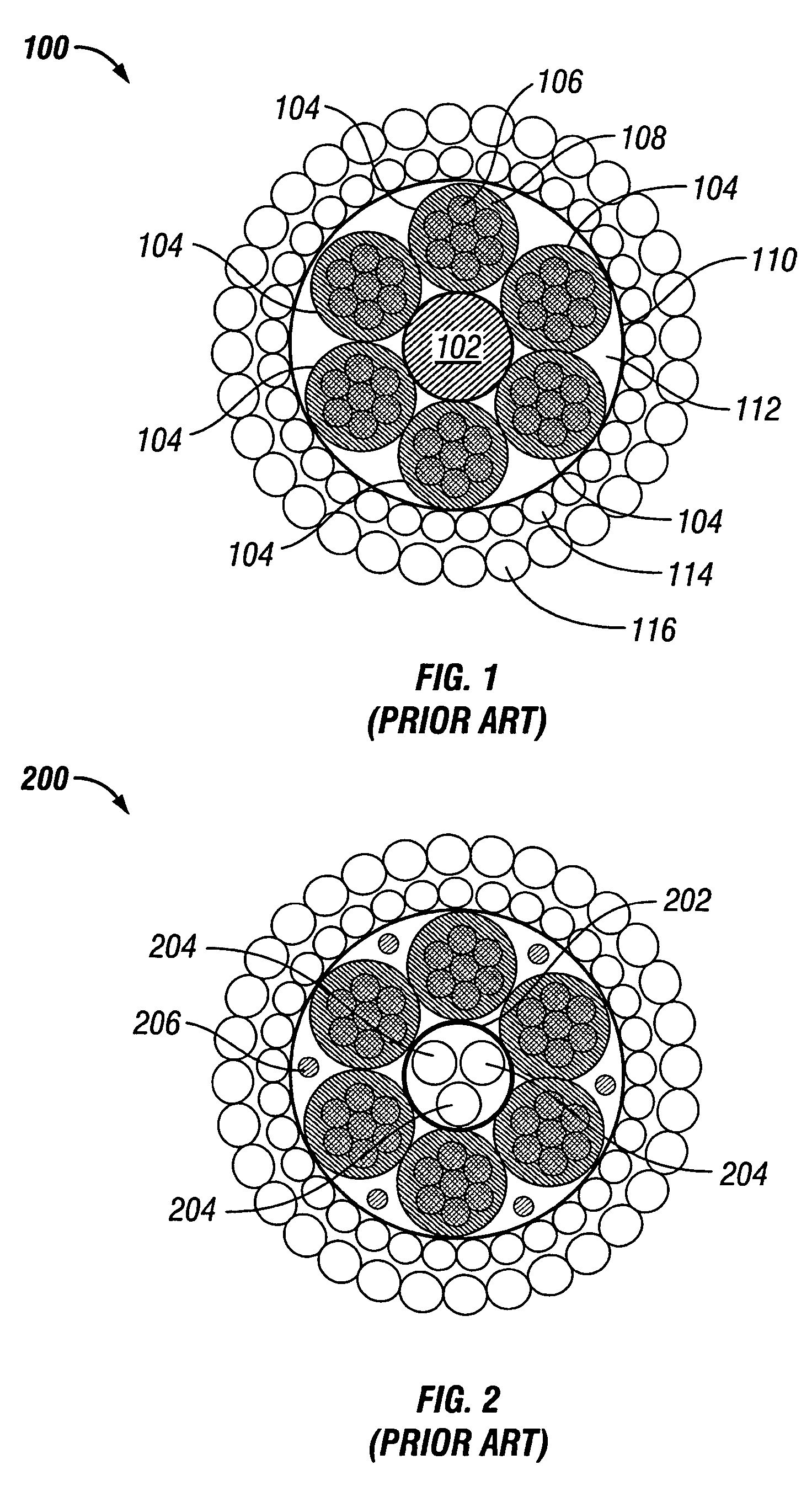Optical fiber cables for wellbore applications
a technology of optical fiber cables and wellbores, applied in the direction of optical fibers, instruments, mechanical structures, etc., can solve the problems of optical fibers that cannot be characterized by comparable stretch/strain characteristics, lack of comparable stretch/strain characteristics, and the possibility of volatilization of volatile organic compounds
- Summary
- Abstract
- Description
- Claims
- Application Information
AI Technical Summary
Problems solved by technology
Method used
Image
Examples
first embodiment
[0034]FIG. 3 illustrates, in cross section, an optical fiber conductor bundle according to the present invention. The conductor bundle 300 includes an optical fiber 302 centrally positioned on the center axis of the conductor bundle 300, and a plurality of metallic conductors 304 (only one indicated) helically positioned around the optical fiber 302. A polymeric insulating material 306 surrounds the metallic conductors 304. Further, the volume between the optical fiber 302 and metallic conductors 304 may be filled with an interstitial filler 308. The conductor bundle 300 may serve as a central conductor bundle, such as the conductor bundle 102 of cable 100 as depicted in FIG. 1. Also, the conductor bundle 300 may be positioned in a cable as one or more outer conductor bundles, for example, by replacing the outer conductor bundles 104 in FIG. 1.
[0035]FIG. 4 is a cross-sectional view of a second illustrative embodiment of the present invention. The conductor bundle 400 has a plurality...
sixth embodiment
[0039]Referring to FIG. 8, which illustrates the present invention, conductor bundle 800 includes a central optical fiber 802 positioned on the central axis of the conductor bundle 800. One or more optical fibers 804 (only one indicated) and a plurality of metal conductors 806 (only one indicated) are positioned helically around the central optical fiber 802. The conductor bundle further includes polymeric insulation material filler 808. The interstitial space 810 formed between the central optical fiber 802, the metal conductors 806, and optical fibers 804, may further be filled with an interstitial filler. The conductor bundle 800 may be employed in cable configuration as central and outer conductor bundles.
[0040]FIG. 9 depicts, in cross-section, a seventh illustrative embodiment of the present invention. The conductor bundle 900 may include any combination of optical fibers 902, metallic conductors 904 (only one indicated), polymeric insulating material 906, or other components a...
eighth embodiment
[0041]Referring to FIG. 10, which illustrates the present invention. The conductor bundle 1000 according to the present invention may further include a jacket encasement 1002 encasing the polymeric insulating material 1004, where the jacket encasement 1002 provides further protection for the conductor bundle 1000. The conductor bundle can include metallic conductors 1006 (only one indicated), optical fibers 1008 (only one indicated), interstitial fillers 1010 (only one indicated), a polymeric insulating material 1004, or any other components in accordance with the invention. Copper or other metallic tape may be used to form the jacket encasement 1002. The jacket encasement 1002 may also be an extrusion of tin and gold alloy solder, any other extrudable metal or metal alloy, or welded metallic tube that is drawn and shaped around the outer periphery of the polymeric insulating material 1004. When metallic tape is used, the seams of the tape may optionally be overlapped or crimped, an...
PUM
 Login to View More
Login to View More Abstract
Description
Claims
Application Information
 Login to View More
Login to View More - R&D
- Intellectual Property
- Life Sciences
- Materials
- Tech Scout
- Unparalleled Data Quality
- Higher Quality Content
- 60% Fewer Hallucinations
Browse by: Latest US Patents, China's latest patents, Technical Efficacy Thesaurus, Application Domain, Technology Topic, Popular Technical Reports.
© 2025 PatSnap. All rights reserved.Legal|Privacy policy|Modern Slavery Act Transparency Statement|Sitemap|About US| Contact US: help@patsnap.com



